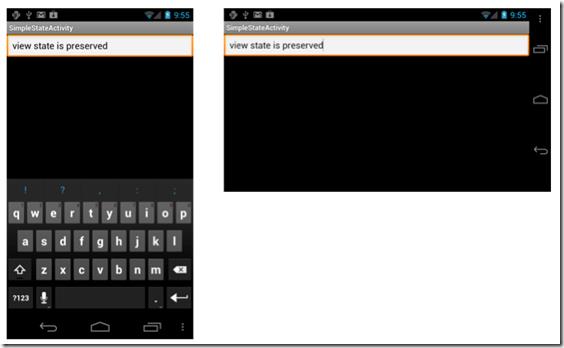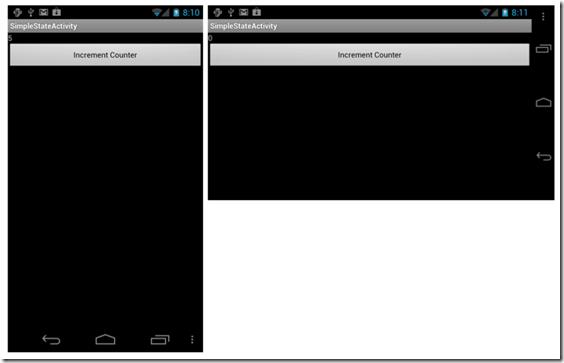屏幕布局和旋转
Posted
tags:
篇首语:本文由小常识网(cha138.com)小编为大家整理,主要介绍了屏幕布局和旋转相关的知识,希望对你有一定的参考价值。
分类:C#、android、VS2015;创建日期:2016-02-06
为了控制屏幕的放置方向(纵向、横向),可以在Resource下同时定义两种不同的布局文件夹:layout和layout-land,这样一来,系统就会根据当前屏幕的放置方向自动请求合适的布局。
注意:<Ctrl>+<F11>是控制模拟器“竖屏/横屏”转换的快捷键。
1、layout和layout-land
要点:
纵向放置方式(portrait,肖像模式)使用的资源保存在layout文件夹下。
横向放置(landscape,景观模式)使用的资源保存在layout-land文件夹下。
默认情况下,当旋转屏幕时,文字会自动旋转(见layout文件夹下的Main.axml源代码)。
<?xml version="1.0" encoding="utf-8"?> <LinearLayout xmlns:android="http://schemas.android.com/apk/res/android" android:orientation="vertical" android:layout_width="fill_parent" android:layout_height="fill_parent"> <Button android:id="@+id/myButton" android:layout_width="fill_parent" android:layout_height="wrap_content" android:text="@string/hello"/> </LinearLayout>
这样设置的好处是:当在设计模式下将屏幕横放时,它就会自动旋转文字。
除了布局文件夹默认的纵向放置方式(portrait)以外,还可以命名一个layout-land文件夹(意为landscape)让其横向放置,而且不需要添加任何代码。
如果layout下有一个Main.axml文件,而且layout-land下也包含一个Main.axml文件,那么,当屏幕横放时,Android就会自动加载layout-land下的Main.axml。
2、在drawable文件夹下指定旋转后使用的绘制资源
与layout和layout-land相似,如果将纵向屏幕和横向屏幕使用的可绘制资源分别保存在Resources/drawable文件夹和Resources/drawable-land文件夹下,旋转屏幕方向时系统同样会自动获取相应的资源文件。例如,在Resources/drawable文件夹下有一个Monkey.png文件,XML描述如下:
<ImageView android:layout_height="wrap_content" android:layout_width="wrap_content" android:src="@drawable/monkey" android:layout_centerVertical="true" android:layout_centerHorizontal="true" />
如果Resources/drawable-land下也有一个Monkey.png,那么,当屏幕横向放置时,它就会自动呈现Resources/drawable-land下的Monkey.png,如下图所示。
3、通过程序控制屏幕旋转
有时我们可能需要在代码中定义布局。与使用XML资源时系统会自动处理屏幕放置不同,当以编程方式添加控件时,必须考虑控件放置的方向。即:必须执行下面的步骤:
- 创建布局。
- 设置布局参数。.
- 创建控件。
- 设置控件的布局参数。
- 添加控件到布局中。
- 将布局作为视图来呈现。
例如,下面的代码将一个TextView添加到RelativeLayout中:
protected override void OnCreate (Bundle bundle) { base.OnCreate (bundle); var rl = new RelativeLayout (this); var layoutParams = new RelativeLayout.LayoutParams ( ViewGroup.LayoutParams.FillParent, ViewGroup.LayoutParams.FillParent); rl.LayoutParameters = layoutParams; var tv = new TextView (this); tv.LayoutParameters = layoutParams; tv.Text = "Programmatic layout"; rl.AddView (tv); SetContentView (rl); }
下图是运行效果:
4、在代码中判断屏幕放置方式
Android提供了一个WindowManager类,在C#代码中,可在OnCreate中通过WindowManager.DefaultDisplay.Rotation属性确定当前设备的放置方向,如下所示:
protected override void OnCreate (Bundle bundle) { base.OnCreate (bundle); var rl = new RelativeLayout (this); var layoutParams = new RelativeLayout.LayoutParams ( ViewGroup.LayoutParams.FillParent, ViewGroup.LayoutParams.FillParent); rl.LayoutParameters = layoutParams; var surfaceOrientation = WindowManager.DefaultDisplay.Rotation; // create layout based upon orientation RelativeLayout.LayoutParams tvLayoutParams; if (surfaceOrientation == SurfaceOrientation.Rotation0 || surfaceOrientation == SurfaceOrientation.Rotation180) { tvLayoutParams = new RelativeLayout.LayoutParams ( ViewGroup.LayoutParams.FillParent, ViewGroup.LayoutParams.WrapContent); } else { tvLayoutParams = new RelativeLayout.LayoutParams ( ViewGroup.LayoutParams.FillParent, ViewGroup.LayoutParams.WrapContent); tvLayoutParams.LeftMargin = 100; tvLayoutParams.TopMargin = 100; } var tv = new TextView (this); tv.LayoutParameters = tvLayoutParams; tv.Text = "Programmatic layout"; rl.AddView (tv); SetContentView (rl); }
当将屏幕从纵向旋转为横向时,运行效果如下图所示:

以上是关于屏幕布局和旋转的主要内容,如果未能解决你的问题,请参考以下文章
